
“Like the Ganga flowing to the South, the Chola glory overflowed across oceans.”— Rajendra Chola’s inscriptions
Prime Minister’s Visit & its importance
The recent visit by Prime Minister of India, shines the limelight on Gangaikonda Cholapuram: But how could an obscure, overshadowed gem from India’s ancient heritage ever garner national attention?
India is reviving the 11th-century capital of the gigantic Chola dynasty in Tamil Nadu, not merely as a historical site but as a symbol of civilizational pride.
This visit carries enormous political, cultural, and historical significance:
Politically, it attempts to consciously emphasize the southern Indian legacy in the broader narrative of Indian identity.
Culturally, it gives recognition to Chola architecture and art, which have vanishingly little of that today. Historically, it gives modern India a glimpse of an empire that once ruled numerous parts of South and Southeast Asia — an empire that excelled in governance, trade, temple construction, and sea power.
But then, why now, and what actually is so special about Gangaikonda Cholapuram that it needs the attention of the Prime Minister?
Hence, India must carve out this forgotten Chola capital and place it in the spotlight as the nation increasingly reclaims and celebrates her indigenous legacies beyond the realm of Delhi. In this blog, we attempt to make an analysis of Gangaikonda Cholapuram’s relevance in history as well as at present times.
Historical Background: What Is Gangaikonda Cholapuram?
The Cholas didn’t just rule land, they commanded minds, myths, and maritime winds.”
— Dr. R. Nagaswamy, Epigraphist
Rajendra Chola I, the son and successor of the famous Rajaraja Chola I, thus established Gangaikonda Cholapuram—literally meaning “City of the Chola who conquered the Ganga”—in the early 11th century CE. More importantly, it stands a memorial to the victorious military expedition under Rajendra Chola northward, filling with possibility the extension of Chola influence all the way up to the Ganges — a feat rarely achieved by southern kings.
Rajendra Chola’s northward campaign wasn’t merely a quest for land — rather, it was a bold statement of imperial ambition and cultural supremacy. In defeating the powerful kingdoms of north India and returning with Ganges water in ceremonial vessels, Rajendra proclaimed the might of the Cholas as not mere Southern rulers, but as Pan Indian Emperors.
Following the unprecedented success of this campaign was the impetus for Rajendra I to shift the imperial capital from Thanjavur to the established city of Gangaikonda Cholapuram around 1025 CE, there, Thereafter he constructed a temple that could compete with the Brihadisvara Temple of Thanjavur, now recognized and preserved as a UNESCO World Heritage Site — the Brihadisvara Temple of Gangaikonda Cholapuram.
This city remained the capital of the Chola kingdom for more than 250 years during which period the dynasty reached its cultural climax and extended maritime trade and the dynasty reached its cultural zenith, expanded maritime trade with Southeast Asia, and built an enduring legacy of temple architecture and inscriptions.
Architectural Brilliance of Gangaikonda Cholapuram
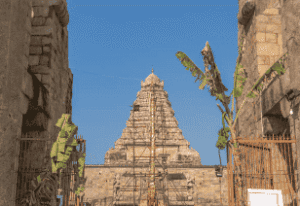
1. Brihadisvara Temple, Gangaikonda Cholapuram
At the heart of Gangaikonda Cholapuram stands its crowning jewel — the Brihadisvara Temple, built by Rajendra Chola I. Though inspired by his father’s Brihadisvara Temple in Thanjavur, Rajendra Chola built a structure that stood apart in its own grandeur and innovation in 1035 CE. Unlike the straight, austere tower of Thanjavur’s Brihadisvara Temple, its 53-meter-high vimana features recessed corners and a graceful, curving ascent that adds a distinct elegance to the structure.
Beyond this UNESCO recognized the three chola temples under the name of Great Living Chola Temples-the Brihadisvara Temple at Thanjavur, the Brihadisvara Temple at Gangaikonda cholapuram and the Airavatesvara Temple at Darasuram.
Vastu-Aligned Urban Design– Gangaikonda Cholapuram wasn’t just a temple complex — it was an entire city thoughtfully laid out according to Vastu Shastra principles. From its roads and water tanks to civic spaces and gateways, the city’s layout aligned with the temple’s central axis, reflecting a grand cosmological vision. Although few records survive today, the remnants still hint at a once-meticulously planned sacred capital.
2. Hidden Marvel: The site of the Royal Palace in Gangaikonda Cholapuram
A short distance from the temple complex, the ruined royal palace of Rajendra Chola lies buried beneath earthen mounds. The Archaeological Survey of India (ASI) has excavated the site, uncovering brick structures, embossed terracotta tiles, and high-quality ceramic fragments. Some of these ceramics may have come from Southeast Asia or even China, suggesting that Rajendra Chola’s court actively maintained cultural and trade links with other powerful empires.
An overview of the excavation highlights from Maligaimedu of Gangaikonda Cholapuram
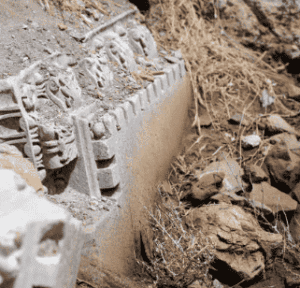
- Western quadrant of temple complex.
- Several east to west brick walls, large foundation plinths, and of course drainage channels.
- The number of Iron nails, terracotta pipes, and terracotta roof tiles implies this structure was probably quite elaborate in nature.
- The patterned organisation of brick in the structure suggests a planned urban settlement as the royal quarters or administrative area of what was the capital of Rajendra Chola.
3. Water engineering from antiquity
The Temple Complex has a great terraced stepped tank called Cholagangam for holding the sacred water from the Ganges River that Rajendra Chola captured and transported back to south India. The tank acted to source water for rituals in the temple’s use and to serve and act as a source of public water, thereby indicating an example of sustainable engineering from 11th-century Chola times.
In fact Cholas were known for tank building. For Example- The Kallanai Dam, also known as Grand Anicut, was built by Karikala Chola and is one of the world’s oldest water-diversion structures still in use today.
4. Fade-Away but Intriguing Murals
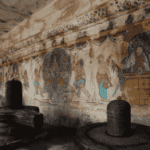
Although many of the original murals have surrendered to the elements over the years, and many have had their surfaces altered by modifications to the temple carvings, work has begun to uncover remnants of ancient wall paintings, comparable in style with the murals at Thanjavur’s Brihadeeswarar Temple, which include:
- Mythological scenes: images of Shiva-Parvati, Nataraja, and other celestial beings.
- Royal processions: Chola kings represented as divine figures receiving blessings or leading armies and expeditions.
- Colors: naturally earth-reds, yellows and ochres from minerals. These murals did not simply adorn walls – they were visual scriptures teaching devotion and cosmology to the temple-goers.
Artefacts and Temple Relics
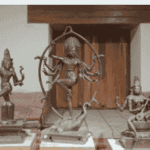
The temple complex and its surrounding areas have yielded numerous artefacts and relics. Authorities have preserved many of these items in museums or secured them under the protection of ASI laws.
- Bronze idols (Chola bronzes): Although nearly all of the original items have been lost or relocated the temple most likely had magnificent examples of Chola bronzes of Shiva as Nataraja, Parvati, and other gods, which are certainly masterpieces of metal casting and symbolic elegance.
- Stone panels and sculptures: The temple walls are adorned with miniature niches housing exquisitely carved forms of Ganesa, Vishnu, Ardhanarishvara, and Durga slaying Mahishasura.
- Inscriptions on artefacts: A few inscriptions on the stone record donations of gold and bronze vessels, musical instruments and lamps — points toward the temple’s explicit ritual, and artistic life.
- Architectural Artefact: The Lion Well- A notable artefact present on-site is Lion-faced well (Yazhi Kinaru) — a small well being held up by a lion, where lion implies protection and sanctity. This status was not common even in Chola times and indicates an important amalgam between functionalist architecture and aesthetic symbolism.
The Ganga Connection: Water, Power & Symbolism
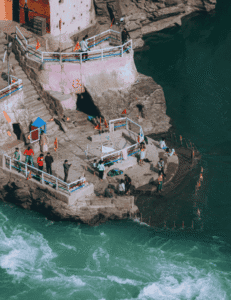
Did the Cholas really bring Ganga water to the southern region?
Yes – and it was not only symbolic. Rajendra Chola I brought ceremonial pots of Ganga water back from his victory in the north – a blatant symbolic act in order to:
Raise Chola Prestige– Rajendra Chola raised the dynasty’s prestige by naming his new capital Gangaikonda Cholapuram (“City of the Chola who conquered the Ganga”), boldly signaling a pan-Indian imperial ambition—something previously seen only with northern dynasties like the Guptas and Harshavardhana.
Not only did this act send a political message. The Cholas were not just south Indian rulers, they were emperors with a footprint extending across the subcontinent.
Cultural Diplomacy– It demonstrated the Chola ability to create linkages between the northern sacred geography and the established Dravidian traditions of the south – they were culturally bridging India.
Legacy: The Brihadisvara Temple at Gangaikonda Cholapuram, as a similar temple to those at Thanjavur, would operate as a cosmic axis – linking the sacred waters of the Ganga with a divine geometry of Chola temple architecture. The Ganga water was not only sanctifying both the royal lineage as well as territory, it was a claim to spiritual and geographic legitimacy.
What Students and UPSC Aspirants Should Know
Gangaikonda Cholapuram is not just a historical site—it’s a high-frequency topic across UPSC papers, especially in GS Paper I and Prelims.
General Studies Paper I – Mains Relevance:
- Art & Culture:
- Example: Temple architecture (Dravidian style), murals, sculpture, water management systems.
- Brihadisvara temples of Thanjavur and Gangaikonda Cholapuram often feature in temple architecture questions.
- Indian History:
- Focus on the Chola Empire’s political expansion, urban planning, and maritime conquests.
History Optional Insights:
- Administrative Model: Local self-government, temple-based revenue records (inscriptions), and detailed land surveys.
- Naval Expeditions: Southeast Asia (Srivijaya, Malay Peninsula) — evidence of India’s early maritime diplomacy and soft power.
Even in the UPSC Prelims, Gangaikonda Cholapuram and the Cholas have featured prominently. For instance, in 2017, the exam included questions related to temple architecture and the Cholas’ overseas expeditions, highlighting their maritime strength and cultural outreach.
Conclusion: Gangaikonda Cholapuram’s Moment of Glory
“In reclaiming sites like Gangaikonda Cholapuram, we are reclaiming the very soul of India’s cultural continuity.” —PM Modi’s recent cultural statements
Once a thriving imperial capital and architectural marvel of the Chola Empire, Gangaikonda Cholapuram has long remained a silent stone giant — admired by historians but largely absent from the popular consciousness. With Prime Minister Modi’s scheduled visit, this long-forgotten city is set to reclaim its place in the national spotlight.
This is more than a political stop — it’s a symbolic reclaiming of India’s rich, yet often overlooked, southern heritage. It may very well signal a renewed interest in restoring, researching, and revering our ancient cultural beacons.
Let this be a call to all students, travelers, and patriots:
Explore the story.
Understand the legacy.
Be a part of preserving India’s hidden gems — before they fade into silence again.
FAQ’S
Answer- Rajendra Chola I built Gangaikonda Cholapuram to commemorate his victory over the Pala dynasty during his northern expedition.
Answer- The name translates to “The City of the Chola who brought the Ganga,” symbolizing Rajendra’s symbolic act of bringing Ganga water to the South.
Answer- The site showcases its majestic Vimana (temple tower), exquisite bronze idols, and inscriptions that detail land grants and water tank constructions.
Answer- The Cholas used the Tiger as their official emblem — a key detail frequently asked in UPSC and academic exams.
Answer- The Kallanai Dam, also known as Grand Anicut, was built by Karikala Chola and is one of the world’s oldest water-diversion structures still in use today.
Read more. Visit more. Preserve more.
Because India’s forgotten capitals are still writing history — if we’re willing to listen.
Do check out UPSC PYQ Blog on Infotrigg.com


good info
Thank you for the auspicious writeup. It in fact was a amusement account it. Look advanced to more added agreeable from you! By the way, how can we communicate?
Thank you so much for your kind words! I’m really glad you enjoyed the write-up. You can reach me directly at sakshipandey2654@gmail.com. I’d be happy to stay in touch and share more insights with you!
There are some fascinating closing dates in this article but I don’t know if I see all of them center to heart. There is some validity however I’ll take maintain opinion until I look into it further. Good article , thanks and we want more! Added to FeedBurner as effectively